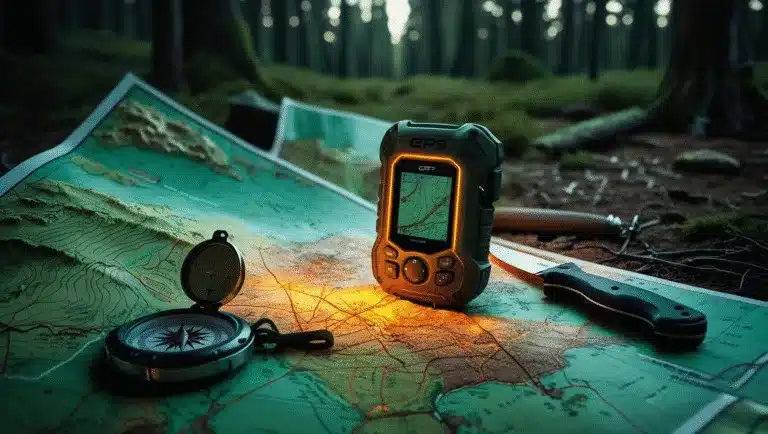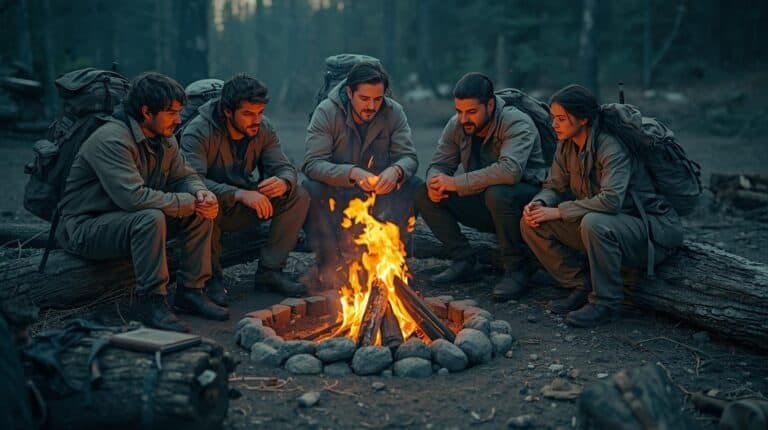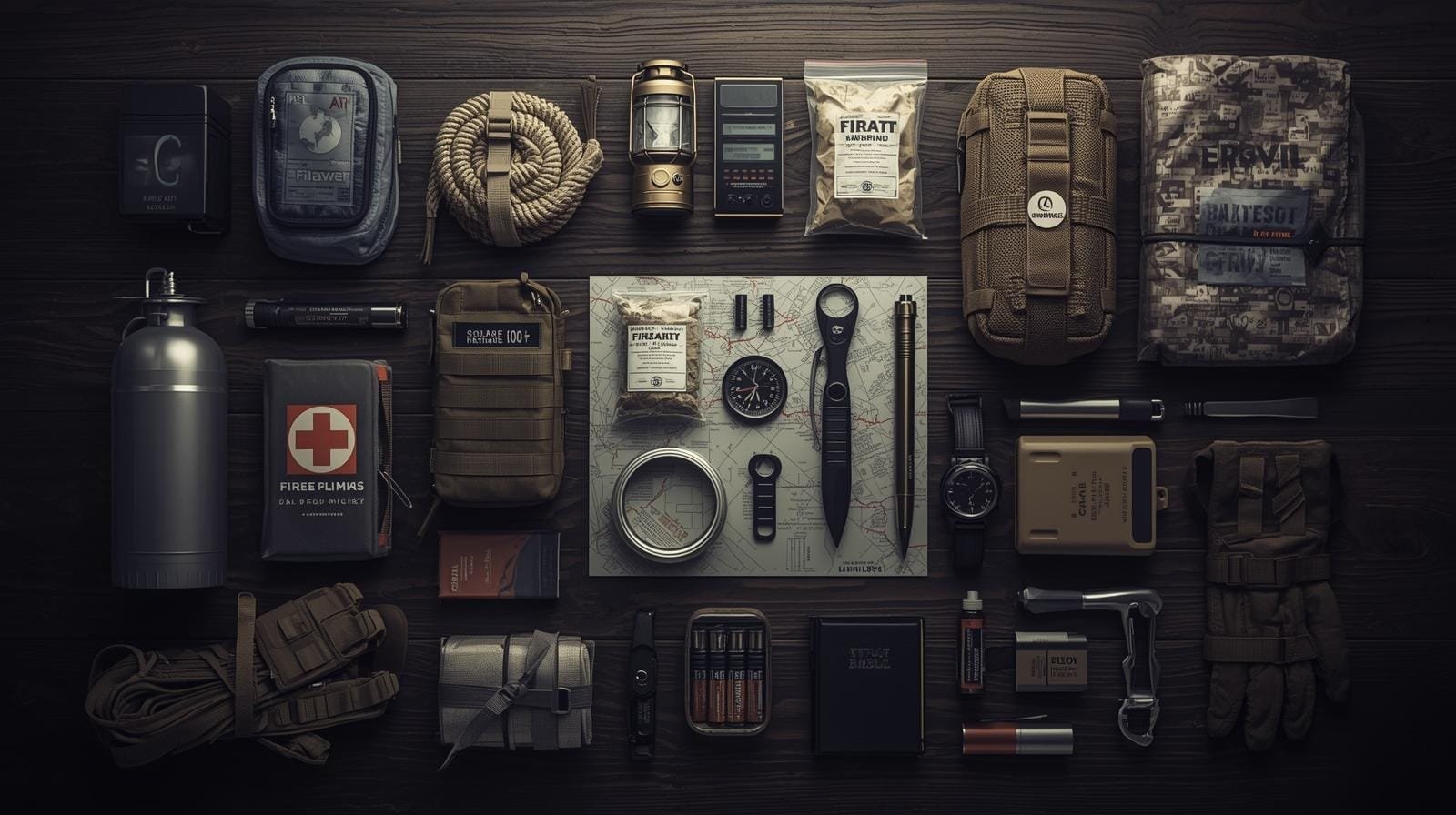
Top 25 Survival Items You’ll Regret Not Having in 2025
The Wake-Up Call
Let’s be honest—most people don’t prepare until they feel the threat breathing down their neck. The news cycle flares up, the shelves empty, and suddenly everyone’s fighting over bottled water and stale granola bars.
By then, it’s too late.
If 2020 taught us anything, it’s that supply chains collapse faster than politicians change opinions. When a storm hits—or an economy tanks—the time to prepare was yesterday. That’s when having the right survival items makes the difference between thriving and just surviving.
That’s why this 2025 checklist isn’t another “just in case” post. These are the top 25 survival items you’ll regret not having when the lights go out, the stores close, and panic buying turns neighborly suburbs into battlegrounds of bad decisions.
Let’s stock smart before the chaos starts.
The 2025 Prepper Reality Check
You can have all the tactical training in the world—but if you’re missing these essential survival items, you’re gambling your survival on luck.
These items aren’t luxury gear; they’re the backbone of resilience. They keep you hydrated, fed, warm, powered, and safe when everyone else is improvising with duct tape and denial. According to FEMA’s Emergency Preparedness Guidelines, most American households have less than three days’ worth of emergency supplies on hand.
So whether you’re building your first bug-out bag or upgrading your home base stockpile, use this as your final gear audit before the next shortage hits. The CDC recommends that every household maintain a comprehensive emergency kit with these critical survival items.
The Top 25 Survival Items You’ll Regret Not Having
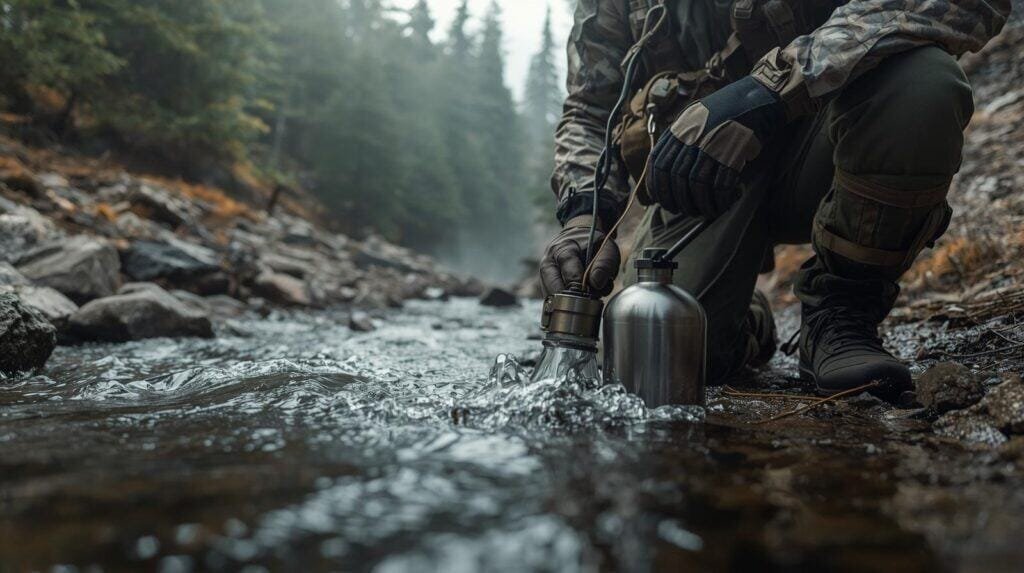
1. Water Filtration System (Non-Negotiable)
Water is your #1 survival currency. Forget the tactical talk—no water, no survival. A quality water filtration system ranks among the most critical survival items you can own.
The EPA estimates that the average person needs one gallon of water per day for drinking and sanitation. Multiply that by your household size and you’ll quickly realize why filtration beats storage alone.
Adventure Wiser Pick: Sawyer Mini or LifeStraw Flex. Both filter up to 100,000 gallons and remove 99.99999% of bacteria.
Pro Upgrade: Consider the Berkey Water Filter for home base operations—it filters larger volumes and removes viruses, heavy metals, and chemicals.
2. Water Storage Containers
From 5-gallon jugs to collapsible bladders, you need both bulk and mobile options. Water storage containers are essential survival items that bridge the gap between your filtration system and your immediate needs.
Pro Tip: Rotate every 6 months to prevent algae growth. Add two drops of unscented bleach per gallon for long-term storage.
Recommended Options:
- WaterBrick Containers: Stackable, modular, and easy to transport
- Reliance Aqua-Tainer: 7-gallon capacity with spigot
- Platypus Platy Bottles: Collapsible options for bug-out bags
According to Red Cross guidelines, you should store at least a two-week supply of water per person in your household.
I have all 3 of the sources above for water storage. This is one area I don’t mess around with. I also store water in old containers for use in the toilet if needed.
3. Mylar Bags + Oxygen Absorbers
Long-term food storage heroes. They keep moisture, light, and oxygen out of your rice, beans, and grains. These are cornerstone survival items for any serious food stockpile.
When properly sealed with oxygen absorbers, staples like rice and wheat can last 20-30 years. That’s not prepper paranoia—that’s food science.
Check current Mylar bag deals on Amazon
Storage Tip: Use 5-gallon food-grade buckets with gamma seal lids to organize your Mylar-sealed survival items. Label everything with contents and date sealed.
4. Freeze-Dried Meals (Lightweight, Long Shelf Life)
Convenient, calorie-dense, and morale-saving. Look for high protein over flavor hype. Freeze-dried meals are among the most practical survival items for both bug-out bags and home stockpiles.
AW Pick: ReadyWise or Mountain House pouches. Mountain House offers a 30-year shelf life and requires only hot water for preparation.
Budget Alternative: Make your own dehydrated meals and vacuum seal them. Sites like Backpacking Chef offer recipes and techniques.
Calorie Considerations: The average adult needs 2,000-2,500 calories per day, but in survival scenarios with increased physical activity, that number jumps to 3,000-4,000 calories. Stock accordingly.
5. Manual Can Opener
Because electric ones stop working when the power does. Don’t laugh—many preppers forget this simple addition to their survival items list.
You can have 200 cans of food, but without a manual opener, you’re smashing them with rocks. The P-38 military can opener is legendary for a reason—small, durable, and effective.
Pro Move: Keep one in every location: kitchen drawer, bug-out bag, vehicle emergency kit, and food storage area. I have 2-3 in my kitchen. Actually I do not own an electric can opener. They break down to fast, the ole manual can opener never lets me down!
6. Multi-Tool (Quality Over Quantity)
Skip the $15 knockoffs. Go for Leatherman or Gerber. Function saves lives. A quality multi-tool is one of those survival items you’ll use weekly in normal times and daily in emergencies.
Top Recommendations:
- Leatherman Wave Plus: 18 tools, 25-year warranty
- Gerber Suspension-NXT: Budget-friendly with solid performance
- Victorinox SwissTool Spirit: Swiss precision engineering
According to Outdoor Life, the average multi-tool provides 15-20 different functions, replacing an entire toolbox in a 6-ounce package.
7. First Aid Kit (And Know How to Use It)
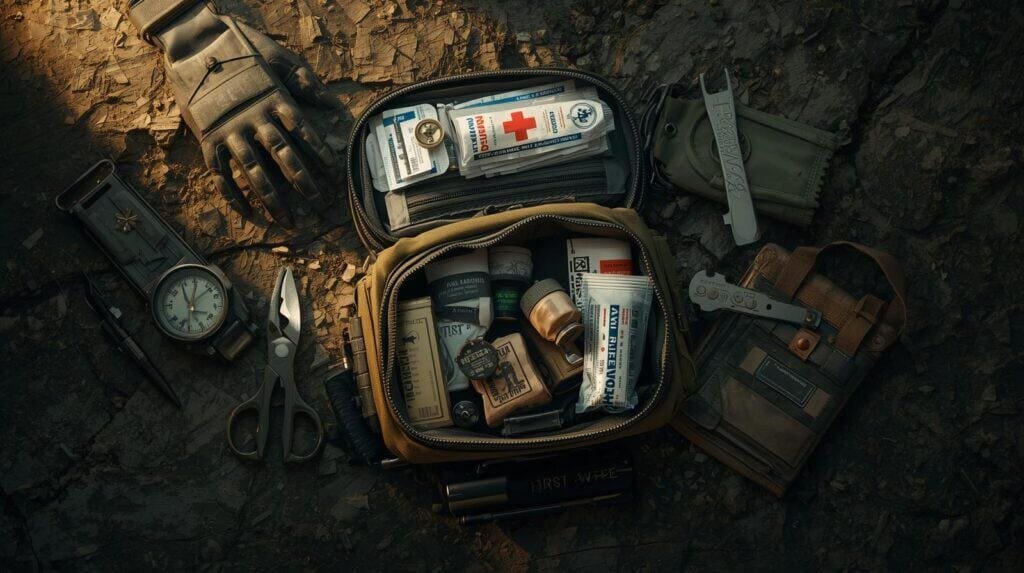
Include trauma supplies: tourniquets, Israeli bandages, QuikClot, shears. A comprehensive first aid kit ranks among the most important survival items because medical help may not be coming.
Adventure Medical or North American Rescue kits. Both are trusted names in the First Aid community.
Critical Additions Beyond Basic Kits:
- Combat gauze with hemostatic agents
- Chest seals for puncture wounds
- SAM splints for fractures
- Burn dressing and cream
- CPR pocket mask
- Trauma shears
- Medical tape (cloth and waterproof)
Training Resources: Take a Stop the Bleed course or wilderness first aid certification from organizations like NOLS or Red Cross.
Pro Tip: Supplies mean nothing without knowledge. YouTube channels like PrepMedic offer excellent trauma training content, but hands-on courses are irreplaceable.
8. Medications & Hygiene Essentials
Prescription refills, antibiotics, soap, feminine hygiene, toothbrushes. Panic smells bad—literally. These often-overlooked survival items can make the difference between maintaining health and facing preventable illness.
Medication Strategies:
- Ask your doctor about 90-day prescriptions
- Research fish antibiotics (veterinary-grade but chemically identical—research thoroughly)
- Stock pain relievers, anti-diarrheals, antihistamines, and antacids
Hygiene Stockpile:
- Soap (bar soap stores longer than liquid)
- Toothpaste and toothbrushes
- Feminine hygiene products
- Baby wipes (multipurpose cleaning)
- Hand sanitizer (60%+ alcohol content)
- Toilet paper and alternatives
The WHO guidelines emphasize that hygiene supplies prevent disease spread more effectively than most medical interventions.
9. Solar Lanterns + Rechargeable Flashlights
No noise, no gas, endless light. These renewable survival items eliminate the need for constant battery or fuel resupply.
Lighting Strategy:
- Area lighting: Solar-rechargeable LED lanterns (LuminAID or MPOWERD)
- Task lighting: Rechargeable headlamps (Black Diamond or Petzl)
- Backup: Lithium-battery flashlights (SureFire or Streamlight)
Pro Tip: Red light preserves night vision and doesn’t attract as much attention as white light in tactical situations.
10. Portable Power Bank (Solar Preferred)
Power up radios, phones, and headlamps. Look for 20,000mAh minimum. Portable power banks are modern survival items that keep communication and navigation devices operational.
Recommended Models:
- Anker PowerCore Solar: 20,000mAh with solar charging
- Goal Zero Nomad: Foldable solar panel with battery pack
- RAVPower Solar Charger: Weather-resistant with multiple ports
According to CNET’s testing, solar charging works best as a supplement rather than primary charging method. Combine pre-charged power banks with solar panels for maximum reliability.
11. Emergency Radio (NOAA + Hand-Crank)
Your only news source when WiFi ghosts you. Emergency radios are critical survival items for receiving weather alerts and emergency broadcasts when cell networks fail.
AW Pick: Midland ER310. It includes NOAA weather alerts, AM/FM radio, flashlight, and USB charging port—all powered by hand crank, solar panel, or batteries. You can never go wrong with one of the most trusted names in hand held radios, Midland!
Alternative: Sangean MMR-88 for better audio quality and reception.
Why NOAA Matters: The National Weather Service broadcasts continuous weather information and emergency alerts on dedicated frequencies that remain operational when commercial stations go dark.
12. Fire Starters (Redundant Systems)
Matches, ferro rod, lighters, and dryer lint in zip bags. Fire = morale + warmth. Multiple fire-starting methods are non-negotiable survival items because fire provides warmth, cooking, water purification, and psychological comfort.
Layered Fire Starting System:
- Primary: Bic lighters (buy in bulk, they’re cheap)
- Secondary: Ferro rod with striker (Light My Fire Swedish FireSteel)
- Tertiary: Waterproof matches (UCO Stormproof)
- Tinder: Dryer lint, cotton balls with petroleum jelly, fatwood
Outdoor Life’s fire-starting guide emphasizes the “rule of threes”: three methods to create fire, three types of tinder, and three ignition sources.
13. Heavy-Duty Tarp & Paracord
Shelter, ground cover, repairs—lightweight lifesavers. Keep a full 100 ft of 550 cord minimum. These versatile survival items serve dozens of purposes from shelter construction to equipment repair.
Tarp Recommendations:
- Size: Minimum 10×10 feet, preferably 12×12 or larger
- Material: Ripstop polyethylene or silnylon for weight savings
- Color: Earth tones for low visibility, bright colors for rescue situations
Paracord Uses: According to 550 Paracord specifications, genuine military-spec paracord has a 550-pound breaking strength and seven inner strands that can be separated for fishing line, sutures, or cordage.
Pro Tip: Learn basic knots: bowline, taut-line hitch, clove hitch, and trucker’s hitch. These four knots handle 90% of survival shelter needs.
14. Sleeping Bag or Emergency Blanket
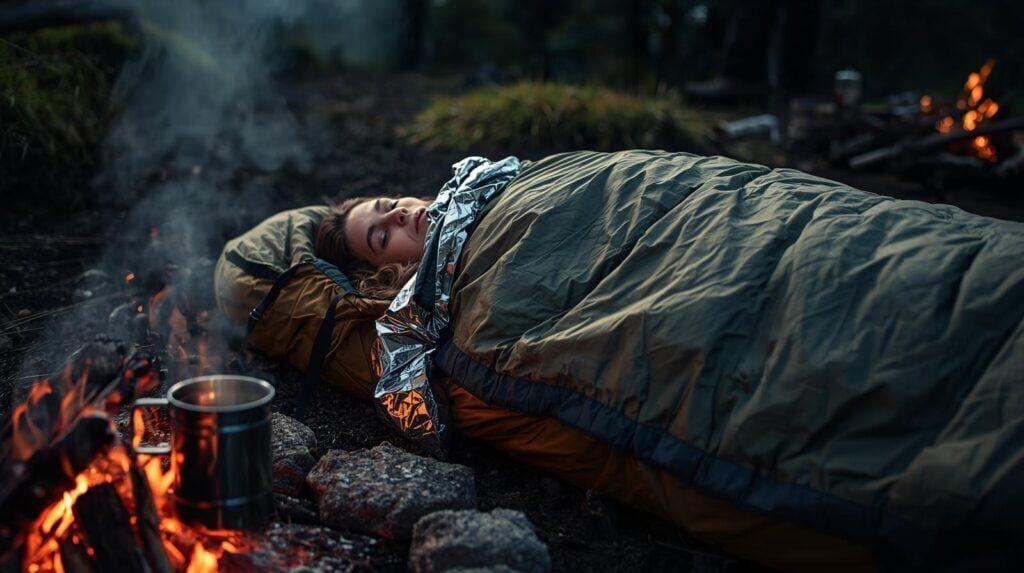
Choose insulation over weight obsession. Hypothermia doesn’t care about your ultralight goals. Quality sleep systems are essential survival items because exposure kills faster than hunger or thirst.
Temperature Rating Guide:
- Summer bag: 35°F+ rating
- Three-season bag: 15°F-35°F rating
- Winter bag: 0°F-15°F rating
- Extreme cold: Sub-zero ratings
Emergency Blankets: Mylar emergency blankets are lightweight survival items that reflect 90% of body heat. Keep several in every kit—they’re cheap insurance against hypothermia.
REI’s sleep system guide recommends choosing a bag rated 10-15°F colder than the lowest temperature you expect to encounter.
15. Proper Footwear + Extra Socks
When you’re bugging out, your feet are your tires. Cotton kills—stick with wool. Quality footwear ranks among the most overlooked survival items, yet foot injuries can immobilize you completely.
Footwear Essentials:
- Primary boots: Waterproof, ankle support, broken in
- Camp shoes: Lightweight recovery footwear
- Socks: Merino wool or synthetic, NEVER cotton
Sock Strategy: Pack at least three pairs per person. The military taught generations the same lesson: take care of your feet or become a casualty.
The American Podiatric Medical Association warns that poorly fitted footwear causes blisters, stress fractures, and infections that can sideline even the toughest individuals.
16. Water-Resistant Clothing Layers
Stay dry or stay miserable. Choose synthetics or Merino wool. Proper clothing belongs on every survival items checklist because exposure and hypothermia kill quickly in wet conditions.
Layering System:
- Base layer: Moisture-wicking synthetic or Merino wool
- Mid layer: Fleece or down for insulation
- Outer layer: Waterproof, breathable shell (Gore-Tex or equivalent)
The Cotton Problem: “Cotton kills” isn’t prepper dramatics. When cotton gets wet, it loses 90% of its insulating properties and dries slowly. Hypothermia can set in at temperatures as high as 50°F with wet cotton clothing.
REI’s layering guide breaks down clothing systems for different climates and activity levels.
17. Portable Stove + Fuel (Propane or Butane)
Cooking equals morale. Keep backups for indoor and outdoor use. Cooking systems are crucial survival items because hot food provides psychological comfort and improves nutrient absorption.
Stove Options:
- Propane: Coleman camp stoves (reliable, widely available fuel)
- Butane: Portable single-burner stoves (compact, indoor-safe)
- Multi-fuel: MSR WhisperLite (burns multiple fuel types)
- Alcohol: Trangia system (silent, no mechanical parts)
Fuel Storage: Store propane and butane canisters in cool, dry locations away from living spaces. A 1-pound propane canister provides approximately 1.5-2 hours of cooking time.
The Adventure Blog recommends calculating fuel needs based on boiling times: roughly 2-3 minutes to boil a liter of water.
18. Cash (Small Bills)
Digital payments fail first. Keep $200–$500 in mixed bills sealed and hidden. Physical currency remains one of the most practical survival items when electronic payment systems fail.
Denomination Strategy:
- Mostly ones and fives (easier to make exact change)
- Some tens and twenties (larger purchases)
- Avoid fifties and hundreds (hard to break, may not be accepted)
Storage: Vacuum seal cash in waterproof bags and store in multiple locations. The FDIC cannot guarantee ATM access during widespread emergencies or grid-down situations.
Bartering Alternatives: Small bottles of liquor, cigarettes, batteries, and ammunition often become unofficial currency in prolonged emergencies.
19. Self-Defense Gear
Depends on your comfort and laws—firearms, pepper spray, or non-lethal tools. Train responsibly. Self-defense tools are controversial but practical survival items that require serious consideration and training.
Options by Comfort Level:
- Firearms: Require training, licensing, and secure storage
- Pepper spray: OC spray with 10% concentration (POM or Sabre)
- Tactical flashlight: High-lumen strobe function (disorienting)
- Personal alarm: 120+ decibel shriek (draws attention)
Legal Considerations: Check USA Carry for state-specific laws on self-defense tools and concealed carry.
Training Resources: USCCA offers firearms training and legal protection resources. For non-lethal options, look for local self-defense courses.
Critical Note: Any defensive tool requires training. Untrained weapon possession creates more danger than safety.
20. Sanitation Supplies
Buckets, liners, bleach, gloves. The smell of unpreparedness spreads faster than disease. Sanitation survival items prevent illness when modern sewage systems fail.
Emergency Sanitation Kit:
- 5-gallon bucket with lid
- Heavy-duty garbage bags (contractor-grade)
- Sawdust or kitty litter (odor control)
- Bleach (disinfection)
- Nitrile gloves
- Hand sanitizer
- Toilet paper (or cloth alternatives)
According to WHO sanitation guidelines, improper waste disposal causes more disease outbreaks in disaster situations than any other factor.
Pro System: The “Humanure Handbook” by Joseph Jenkins provides composting toilet strategies for long-term waste management.
21. Maps + Compass (Learn to Use Them)
GPS is great—until it isn’t. Learn pace count and azimuth basics. Navigation tools are timeless survival items because technology fails, but maps and compasses don’t require batteries or satellites.
Navigation Essentials:
- Topographic maps of your region (USGS maps)
- Compass with declination adjustment (Suunto or Silva)
- Map case (waterproof)
- Protractor for precise bearing calculations
USGS National Map offers free downloadable topographic maps. Print and laminate key areas around your home and bug-out routes.
Skills to Learn:
- Triangulation (determining your position)
- Pace count (measuring distance traveled)
- Terrain association (matching ground to map)
- Azimuth following (walking a bearing)
22. Duct Tape + Zip Ties
You’re never too prepared for improvisation. Think repairs, first aid, and makeshift tools. These simple survival items solve hundreds of problems from gear repair to emergency splinting.
Duct Tape Uses:
- Gear repair (packs, tents, tarps)
- Blister prevention and treatment
- Emergency splinting
- Waterproofing seams
- Cordage substitute
Zip Tie Applications:
- Securing items to packs
- Cable management
- Makeshift handcuffs (security)
- Binding materials together
- Temporary hose repairs
Pro Tip: Wrap duct tape around trekking poles, water bottles, or lighters to save space and keep it accessible.
23. Extra Batteries (Rechargeable Preferred)
Keep multiple sizes, labeled by device. Store in dry containers. Battery stockpiles are often-forgotten survival items that keep essential electronics operational.
Battery Strategy:
- AA and AAA: Most common, buy rechargeable (Eneloop)
- CR123A: High-performance lithium for flashlights
- 18650: Rechargeable lithium for high-drain devices
- Solar charger: For recharging AA/AAA batteries
Storage: The Battery University recommends storing batteries at 50% charge in cool, dry locations. Remove batteries from devices during long-term storage to prevent corrosion.
Shelf Life:
- Alkaline: 5-10 years
- Lithium: 10-15 years
- Rechargeable NiMH: 3-5 years
24. Protective Gloves + Eye Protection
Injury prevention = survival multiplier. Cuts and infections end more people than gunfights. These basic survival items prevent the small injuries that lead to serious infections.
Glove Types:
- Work gloves: Leather for heavy-duty tasks
- Nitrile gloves: Medical procedures and sanitation
- Wool glove liners: Cold weather dexterity
- Waterproof gloves: Wet conditions
Eye Protection:
- Safety glasses or goggles (impact-rated)
- Shatter-resistant lenses
- Side shields for debris protection
According to OSHA statistics, 70% of workplace eye injuries result from not wearing proper protection. Those same hazards multiply in survival situations.
25. Mental Resilience Gear
Bible, journal, playing cards, or something that keeps your mind anchored. Because gear keeps you alive—but mindset keeps you human. Mental health survival items matter as much as physical supplies.
Psychological Survival Tools:
- Sacred texts (Bible, prayer book, devotional)
- Journal and pen (processing emotions)
- Entertainment (books, cards, games)
- Photographs (family connection)
- Music source (small harmonica, etc.)
The American Psychological Association emphasizes that psychological resilience determines long-term survival outcomes more than physical preparedness alone.
Why This Matters: Disasters create trauma. Having mental anchors—whether faith, family photos, or simple games—prevents despair from overwhelming your survival instinct.
Seasonal Stockpiling Strategy — Timing Is Everything
The preppers who win aren’t the ones with the biggest stash—they’re the ones who buy their survival items before panic hits.
Spring–Summer 2025 Priorities:
- Water filters and storage containers
- Food storage supplies (Mylar bags, oxygen absorbers)
- Power sources (solar chargers, power banks)
- Cooling strategies (battery-powered fans)
- Snake bite kits and insect protection
Fall–Winter 2025 Priorities:
- Warmth gear (sleeping bags, thermal clothing)
- Medical refills (stock up before flu season)
- Hygiene stock (cold and flu supplies)
- Fuel backups (propane, butane, firewood)
- Winter-specific survival items (ice cleats, hand warmers)
Economic Timing: Buy during off-season sales. Camping gear drops in price during fall and winter. Cold-weather supplies discount in spring and summer.
The goal isn’t hoarding—it’s timing. Stock smart, not scared. Consumer Reports tracks seasonal pricing patterns to help you maximize value.
Wrapping Up — Preparation Is the Best Insurance
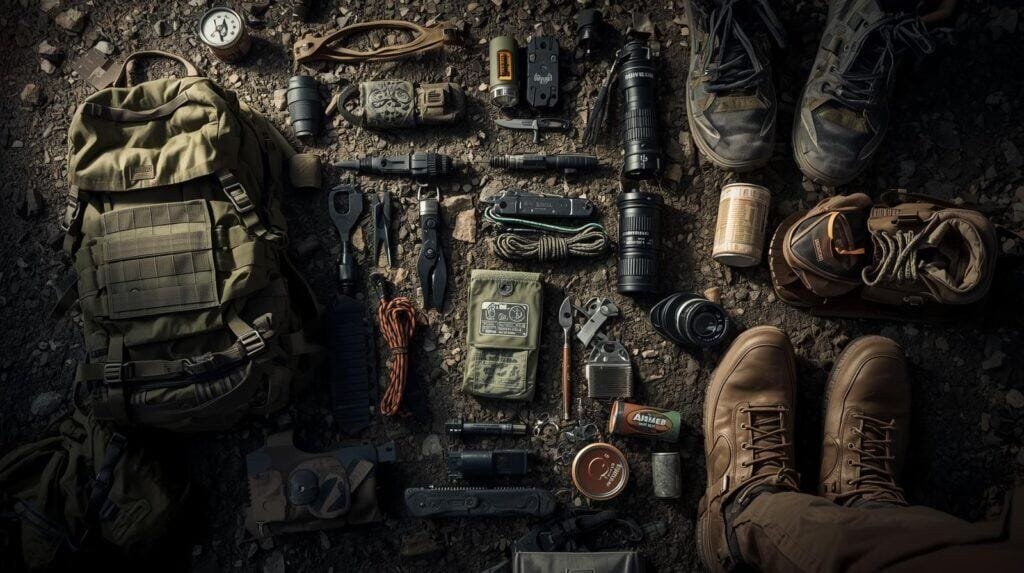
Every disaster proves the same point: those who prepare early suffer least.
Start with these 25 essential survival items. Audit your gear quarterly. Rotate supplies regularly. And remember—the prep you do today makes tomorrow survivable.
These survival items aren’t about living in fear—they’re about living with confidence. When you’ve invested in quality gear and practical skills, you sleep better knowing you’re ready for whatever comes.
The difference between survivors and victims often comes down to a simple choice: prepare now or scramble later. Those who stock critical survival items before crisis hits avoid the panic, the shortages, and the price gouging that define emergency scrambles.
Don’t wait for the news to scare you into action. Don’t wait for empty shelves to teach you this lesson. Start building your stockpile of essential survival items today—one item, one paycheck, one decision at a time.
Because when the lights go out and the stores close, the only survival items that matter are the ones already in your possession.
Your preparedness starts now. Which of these 25 survival items will you acquire first?
Next Steps: Continue Your Preparedness Journey
➡ The Smart Prepper’s Pantry: Build a Food Stockpile Without Going Full Doomsday — Learn how to stock food supplies that you’ll actually eat, with rotation strategies and budget-friendly bulk buying tips.
➡ 10 Rookie Bug-Out Bag Mistakes and How to Avoid Them — Don’t let common errors compromise your evacuation readiness. This guide covers weight distribution, gear selection, and what NOT to pack.
➡ Strength in Stillness: Finding Peace Amid Chaos — Because having survival items means nothing without the mental resilience to use them effectively. Learn how to maintain psychological stability when everything falls apart.
For more comprehensive preparedness resources, check out Ready.gov, FEMA’s Emergency Preparedness, and CDC Emergency Preparedness and Response.
Remember: The best time to prepare was yesterday. The second-best time is right now.
Heads-Up, Fellow Preppers:
Some links in this post are sponsored or affiliate links. If you click and buy, I may earn a small commission—enough to restock my peanut butter and maybe add one more can of chili to the stash. I only recommend gear I trust, use, and would hide in a bug-out bag.

